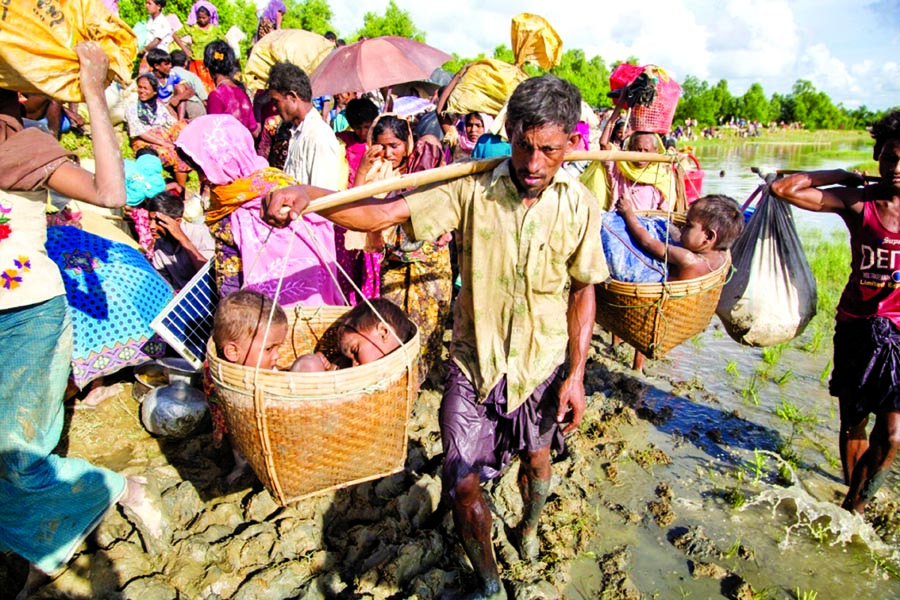
Kazi Zahidul Hasan :
UN-led aid agencies and the Bangladesh authorities are preparing themselves to host a larger influx amid yesterday’s sudden surge of Rohingya refugees to Bangladesh driven by fear of fresh violence and starvation in Myanmar’s Rakhine State, officials said.
“UN aid bodies, including the UNHCR, are working with the Bangladesh authorities on a transit centre to prepare for a potential refugee influx in the coming days,” Adrian Edwards, spokesman for the UN Refugee Agency, told a news briefing in Geneva on Tuesday.
Border Guard Bangladesh (BGB) says that more than 11,000 Rohingya refugees crossed by land on Monday into South-Eastern Bangladesh through several points.
The new arrivals have now been moved away from the border areas into established camps and settlements in the Kutupalong and Balukhali area.
“We’re coordinating with the government and partners to provide urgent services – food, water and healthcare – to these new refugees,” Adrian Edwards.
To prepare for possible further new arrivals, UNHCR’s government counterpart, the Refugee Relief and Repatriation Commission (RRRC), has agreed to set up small first aid stations at entry points to provide water and attention for major medical emergencies among the fresh arrivals.
In addition, RRRC has allocated land to set up a transit centre in the Kutupalong extension site. It will lead preparedness activities with UNHCR in coordination with partners including WFP, UNICEF, IOM, WHO, ICRC and ACF. Basic assistance will also be provided at the entry points.
“We’re back in a situation of full alert as far as influxes are concerned. It is a big increase to see 11,000,” said Adrian Edwards.
Many of the new refugees came from the Buthidaung area in Myanmar’s northern Rakhine State, which is 20-25 kilometers east of Maungdaw. “Some said they had fled torching and killings back home; one boy was seen with a big gash across his neck,” Edwards said.
“We don’t know at the moment what is driving this,” he added. “Some of these people have fled their homes several days ago and in some cases two weeks ago, so they moved toward the border before coming across.”
There are also indications of more recent problems.
“As you may have seen from media reports which I can’t verify, but there are reports about fires being seen close to the border (and) other problems there,” Edwards said.
“We’re keen to provide shelter to the Rohingyas who are arriving in Bangladesh. The government allocated 3,000 acres of land to provide them shelter,” Mohammad Shah Kamal, Secretary for the Ministry of Disaster Management and Relief, told The New Nation yesterday.
“People are still coming. Preparation is underway for new larger influx. We have planned to put up 150,000 tarpaulin shelters for them,” he added.
About 520,000 Rohingyas have fled Bangladesh from Myanmar since 25 August when attacks by Rohingya militants on security posts in Rakhine State triggered a nasty military crackdown, but the rate had slowed to about 2,000 refugees per day last week, aid agencies say.
Refugees and rights groups say the army and Buddhist vigilantes retaliated by engaging in a campaign of killing and arson aimed at driving the Rohingya out of Myanmar.
Rohingyas arriving in Bangladesh said food was running out because the state government had closed village markets and restricted the transport of food, apparently to cut supplies to drive out the Rohingya.
They said the Myanmar security forces have also asked to clear 15 Rohingya villages of Rakhine State recently fuelling fears of fresh violence.
“The situation is getting worse. We have no food and no guarantee of security,” said a Rohingya, who arrived a makeshift camp in Cox’s Bazar on Monday.
He said: “A lot of people were preparing to flee “.
The Myanmar government had claimed its “clearance operations” against the militants ended in early September and people had no reason to flee.
Meanwhile, the international humanitarian organisations are scrambling to provide food, water and medical care to the traumatised people who have arrived since August – as well as the 300,000 refugees who had fled previous bouts of violence.

